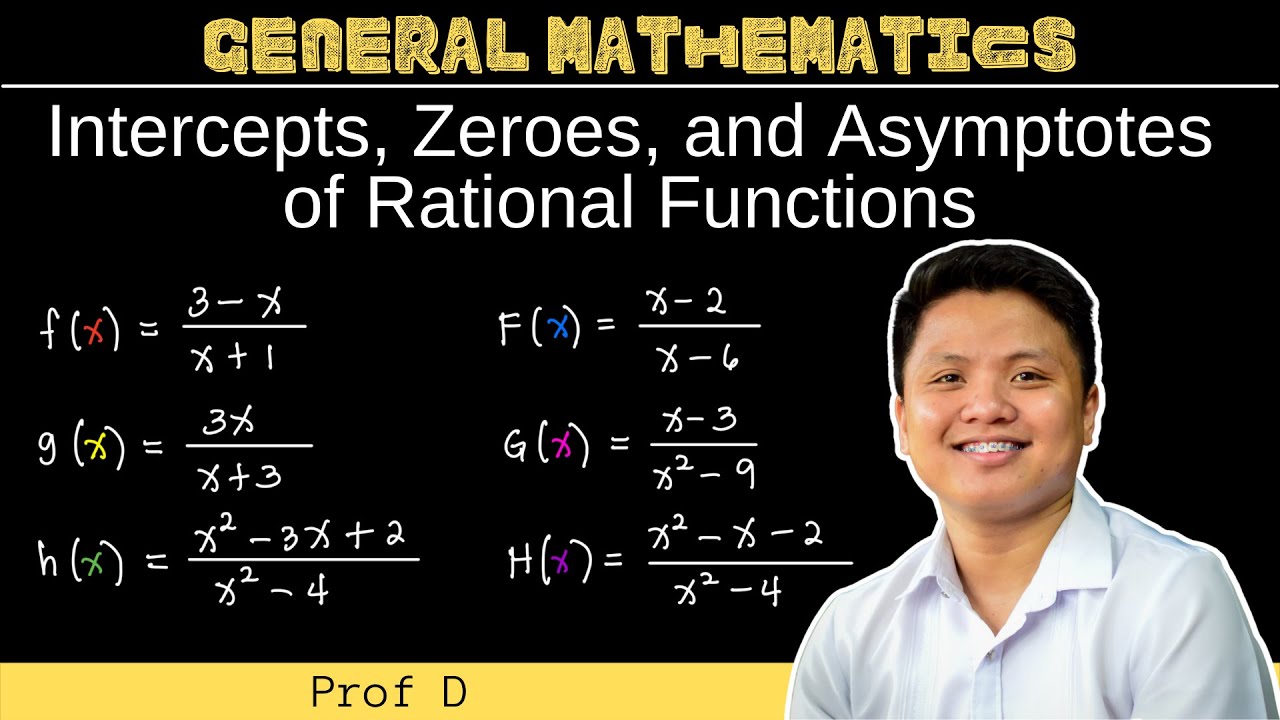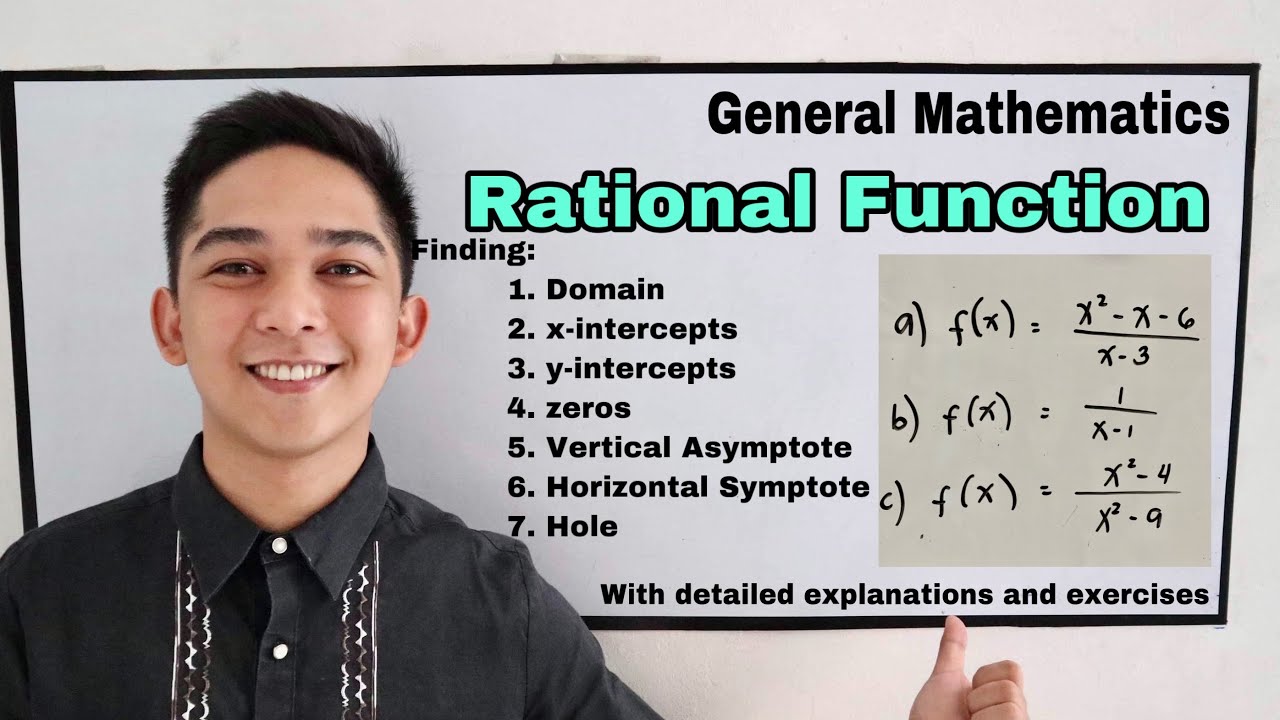INTERCEPTS OF RATIONAL FUNCTIONS || GRADE 11 GENERAL MATHEMATICS Q1
Summary
TLDRThis educational video script explains the concept of intercepts for rational functions, focusing on how to find x and y-intercepts. It illustrates the process with examples, showing how to substitute values to solve for intercepts and emphasizing that not all rational functions have both intercepts due to the possibility of no real solutions. The script guides viewers through the steps for each example, highlighting the importance of factoring and cross-multiplication in finding intercepts, and concludes with an encouragement to engage with the content for more tutorials.
Takeaways
- 📌 Intercepts of rational functions are the x or y-coordinates where the graph crosses the x-axis or y-axis, respectively.
- 🔍 The y-intercept is found by substituting 0 for x and solving for y, while the x-intercept is found by substituting 0 for y and solving for x.
- ⚠️ Not all rational functions have both x and y intercepts; if there are no real solutions, there are no intercepts.
- 📚 Example 1: For the function f(x) = (x + 4) / (x - 2), the y-intercept is -2 and the x-intercept is -4.
- 📝 Example 2: For the function f(x) = (x^2 + 5x + 4) / (x^2 - 2x - 3), the y-intercept is -4/3 and the x-intercept is -4.
- 🔢 In Example 2, the numerator and denominator are trinomials, and factoring is necessary to find the intercepts.
- 📉 Example 3: For the function f(x) = (x^2 + 16) / (x^2 - 4), the y-intercept is -4, but there is no x-intercept because the equation x^2 + 16 = 0 has no real solutions.
- 📚 The process involves setting the function equal to zero and solving for the intercepts, which may require cross-multiplication and factoring.
- 🔍 The video script provides step-by-step examples to demonstrate how to find intercepts for different types of rational functions.
- 👍 The video encourages viewers to like, subscribe, and hit the bell button for more educational content.
- 📚 The script is part of a series of tutorials aimed at helping viewers learn about rational functions and their properties.
Q & A
What are intercepts in the context of rational functions?
-Intercepts are the x or y-coordinates of the points where a graph of a rational function crosses the x-axis or y-axis, respectively. They are referred to as x-intercepts and y-intercepts.
What is a y-intercept and how is it found?
-A y-intercept is the y-coordinate of the point where the graph of a function crosses the y-axis. It is found by substituting 0 for x in the function and solving for y.
What is an x-intercept and how is it found?
-An x-intercept is the x-coordinate of the point where the graph of a function crosses the x-axis. It is found by setting the function equal to 0 and solving for x.
Why might a rational function not have both x and y intercepts?
-A rational function might not have both x and y intercepts if it has no real solutions, meaning the function does not cross the axes at any real number points.
What is the y-intercept of the function f(x) = (x + 4) / (x - 2)?
-The y-intercept of the function f(x) = (x + 4) / (x - 2) is -2, found by substituting x with 0 and solving the resulting equation.
What is the x-intercept of the function f(x) = (x + 4) / (x - 2)?
-The x-intercept of the function f(x) = (x + 4) / (x - 2) is -4, found by setting the function equal to 0 and solving for x.
How do you find the y-intercept of the function f(x) = (x^2 + 5x + 4) / (x^2 - 2x - 3)?
-The y-intercept is found by substituting x with 0 in the function, which results in -4/3 for this particular function.
How do you find the x-intercept of the function f(x) = (x^2 + 5x + 4) / (x^2 - 2x - 3)?
-The x-intercept is found by setting the function equal to 0 and solving for x. For this function, x = -4 is the solution, indicating the x-intercept.
What is the y-intercept of the function f(x) = (x^2 + 16) / (x^2 - 4)?
-The y-intercept of the function f(x) = (x^2 + 16) / (x^2 - 4) is -4, as the constant term 16 divided by the constant term -4 in the denominator gives -4.
Why does the function f(x) = (x^2 + 16) / (x^2 - 4) not have an x-intercept?
-The function does not have an x-intercept because when setting the function equal to 0 and solving for x, the result is x = ±√(-16), which has no real solutions.
What does the video suggest to do after learning about intercepts?
-The video suggests liking, subscribing, and hitting the bell button for more video tutorials on the topic, indicating a call to action for continued learning.
Outlines

Этот раздел доступен только подписчикам платных тарифов. Пожалуйста, перейдите на платный тариф для доступа.
Перейти на платный тарифMindmap

Этот раздел доступен только подписчикам платных тарифов. Пожалуйста, перейдите на платный тариф для доступа.
Перейти на платный тарифKeywords

Этот раздел доступен только подписчикам платных тарифов. Пожалуйста, перейдите на платный тариф для доступа.
Перейти на платный тарифHighlights

Этот раздел доступен только подписчикам платных тарифов. Пожалуйста, перейдите на платный тариф для доступа.
Перейти на платный тарифTranscripts

Этот раздел доступен только подписчикам платных тарифов. Пожалуйста, перейдите на платный тариф для доступа.
Перейти на платный тарифПосмотреть больше похожих видео

Intercepts, Zeroes, and Asymptotes (Horizontal/Vertical) of Rational Functions | General Mathematics

Rational Function (Domain, x & y - Intercepts, Zeros, Vertical and Horizontal Asymptotes and Hole)

Relasi dan Fungsi Matematika Kelas 10 • Part 26: Fungsi Rasional Bentuk 3 - Kuadrat / Linear

Fungsi Rasional Bentuk 1 (Domain, Range, Cara Menggambar)

X- AND Y- INTERCEPTS OF GRAPHS OF POLYNOMIAL FUNCTION|| GRADE 10 MATHEMATICS Q2

AP Precalculus – 4.2 Parametric Functions Modeling Planar Motion
5.0 / 5 (0 votes)
